Western Cape "Wow!"
We have a long weekend due to the South African national holiday, Youth Day, so Krishna and I booked a tour called Western Cape “Wow!” that will take us all over Western Cape Area.
After collecting all thirteen members of our group, our first stop on our tour was along on one of the most scenic drives in the world, Chapman’s Peak Drive. It runs parallel to the almost vertical face of the mountain from Hout Bay to Noordhoek. Our tour guide, Z, explained that the road was considered a huge engineering feat for its time in the early 1900’s, but that unfortunately in the 1990’s had been closed due to a huge boulder falling and killing an entire car full of travellers. In 2005, it was re-opened after some improvements to the structure. In addition, after every rainstorm, it closes until it is determined that no large boulders are at risk of falling. However, Z said his favorite part of the drive is that is the route of two of South Africa’s biggest races, the Two Oceans Marathon and the Cape Argus Cycle Race.
View from Chapman’s Peak Drive
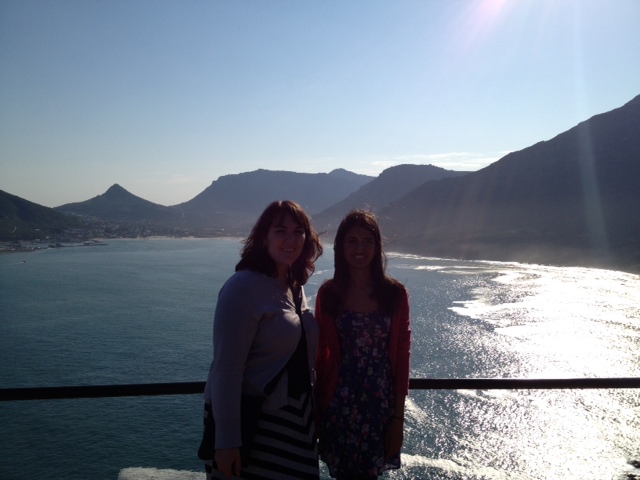
Our second stop was an ostrich farm. While ostriches do live in the wild, they are also raised on farms in South Africa for their huge eggs, soft feathers, and delicious meat. We were able to feed both a male and female ostrich. We were instruct to feed the using a flat hand to avoid injuries to our fingers. Although they were both “domesticated” they were very eager to be fed, and pinched my palm with their beaks in their quest to eat all the ostrich feed.
Feeding the Ostrich
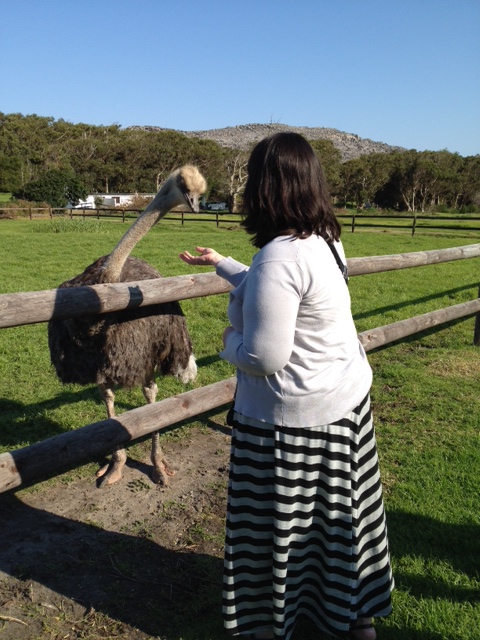
Next, we made the drive to the Cape of Good Hope and Cape Point, the tip of the Western Cape’s peninsula. Although many mistakenly think this is the southernmost point of Africa, it is actually the most south-western point of Africa. The first European to visit the Cape of Good Hope was Portuguese explorer, Bartholomew Dias. He and his crew were attempting to find a sea route to Asia. Dias originally named it the “Cape of Storms,” because of the very rough seas they encountered, but it was renamed by another Dutch explorer due to his optimism in starting the profitable business route with the Far East. After eating lunch at Cape Point’s restaurant, the Two Oceans, we were given the option to either ride the funicular cable car , the Flying Dutchman, or to climb to the top of the cliff and Cape Point’s lighthouse. We chose the latter to save a little money and work off our hearty lunch. We were rewarded with one of the most beautiful views I have ever seen of the mountains and the ocean. We also had a great view of Table Mountain National Park which hosts the brush plants known as fynbos that only grow in this area of South Africa.
Cape of Good Hope

Cape Point Lighthouse
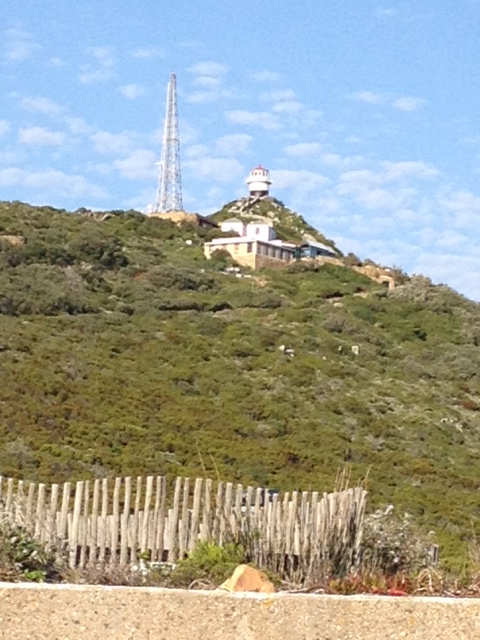
View from Our Climb

Krishna Enjoying the Cape Point Cliffs
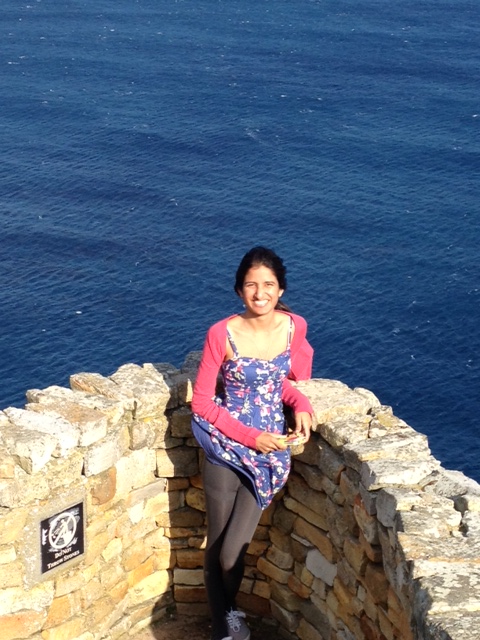
View from the Lighthouse
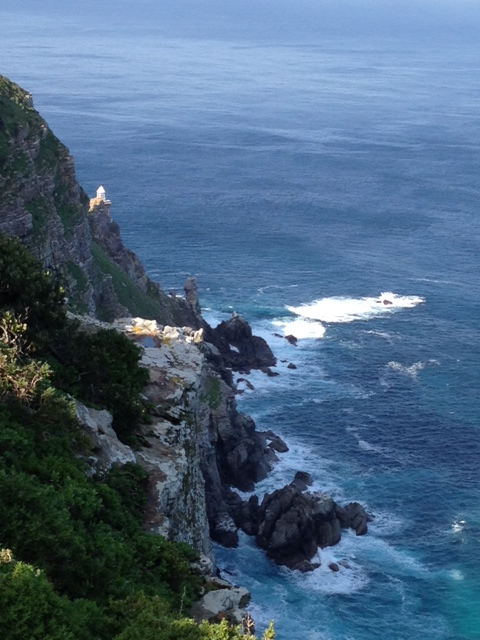
After climbing down, our group drove to our accommodation for the evening in Stellenbosch. Stellenbosch is known for two things: its college town vibe due to the respected University of Stellenbosch and its famous vineyards. We ate dinner a local restaurant, and exhausted after our long first day, went to bed early.
We awoke early the next day, and headed to our first destination, Kayamandi Township. Townships are one of the many remnants left from the apartheid regime in South Africa They are urban living areas usually built on the periphery of large cities and were reserved for “non-whites,” which according the regime, included the categories, Black African, Coloureds, and Indians. Kayamandi was originally built as hostel housing for black African male farm workers, but later these workers’ wives and families forced their way into the area creating the community that still exists today. Our tour guide Z left us with our township guide, who was also a resident of Kayamandi. He explained that Kayamandi means, “nice home,” in Xhosa, the primary language of Kayamandi’s residents, and that people remained in this township after the end of apartheid because its residents are able to stay there rent free and with free water access. The only housing related expense they must pay is electricity. He walked us through the maze-like alley ways between the steel-sided shack houses and proudly pointed out the several solar panels, the community garden plot, and the township’s public library. I felt that it was strange that our group had made a tourist attraction out of this impoverished area, and was a bit uncomfortable at first at the prospect of our tour. However, the residents seemed to welcome our presence and I hope our tour helped to support the township in some small way.
A Township Shop
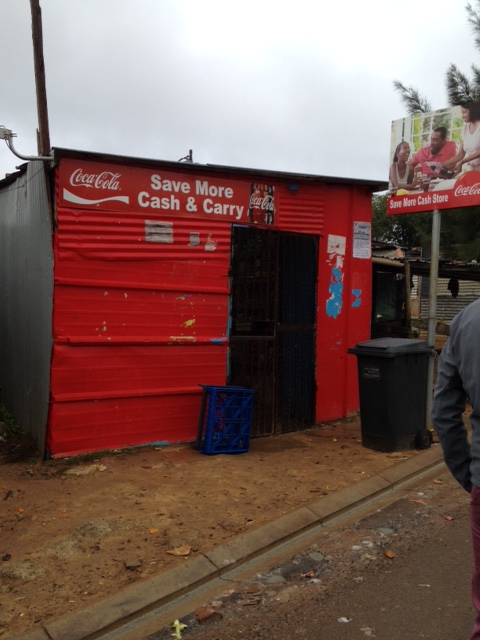
Steel-sided Shacks
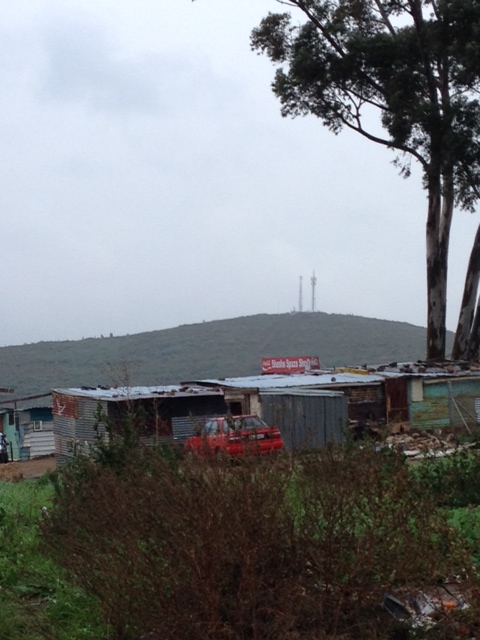
After finishing our tour, we went wine tasting at two wineries in Paarl. With our first tasting, we were able to try several different wines paired with cheeses designed to bring out their flavour. The wines rivaled those I have tried in France, California, and Italy, but were much more reasonably priced. I believe the most expensive bottle I purchased was only ten U.S. dollars! My favorite was the spicy, bold Shiraz. At the second winery, we were treated to fortified dessert wines, also called port, paired with different chocolates. Although I enjoyed the chocolates, I must admit that the sweet ports were not my favorite.
Wine and Cheese Tasting
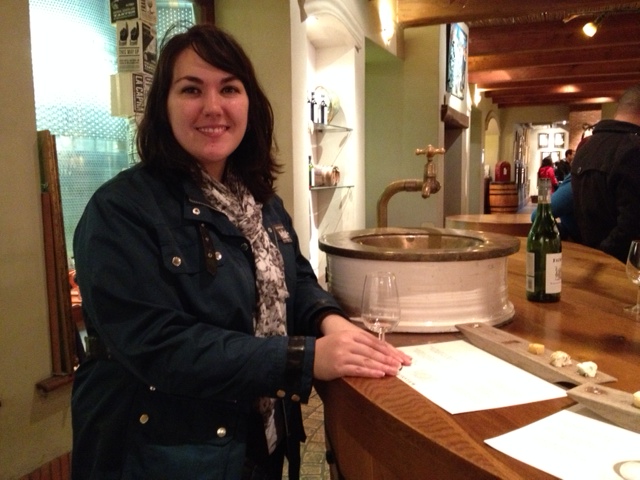
Our Tour Group at the Dessert Winery
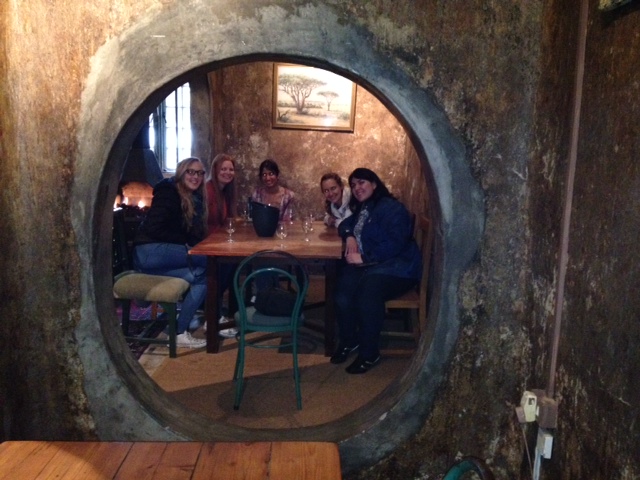
Chocolate and Port Tasting
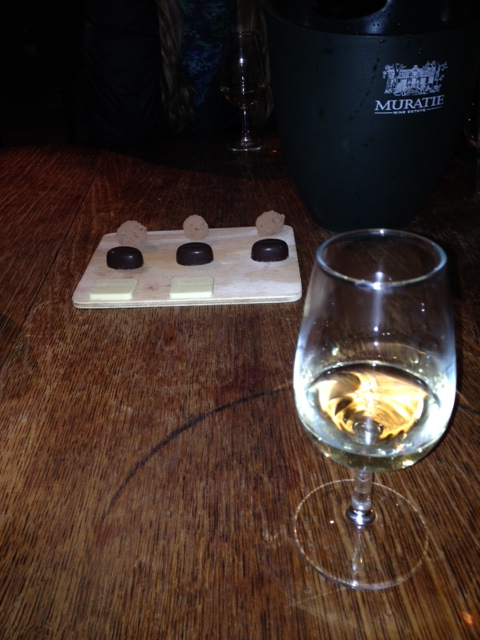
We then made the long drive to Cape Agulhas, which is the actual southernmost point of Africa. It is also where the two oceans, the Atlantic and the Indian, officially meet. It was quite chilly by the time we made it to the beach, but we took the time to get a group photo. After our “photo op” we went to our hostel. It was a very fun atmostsphere and the staff had prepared a braai, South Africa barbeque for us. We spent the evening relaxing in the common area and playing pool. Our best player was Oleg, a Russian student. In addition to being a great shot, he also helped restrain the very enthusiastic hostel dog who liked to steal the pool balls. Unfortunately, before going to bed we were informed that the next day’s first scheduled activity, shark cage diving, had been cancelled due to the anticipated stormy weather. Although our group was very disappointed, it meant that we could sleep in a few more hours the next morning. Hopefully Krishna and I can schedule a dive for a later weekend.
Cape Agulhas: Where the Two Oceans Meet
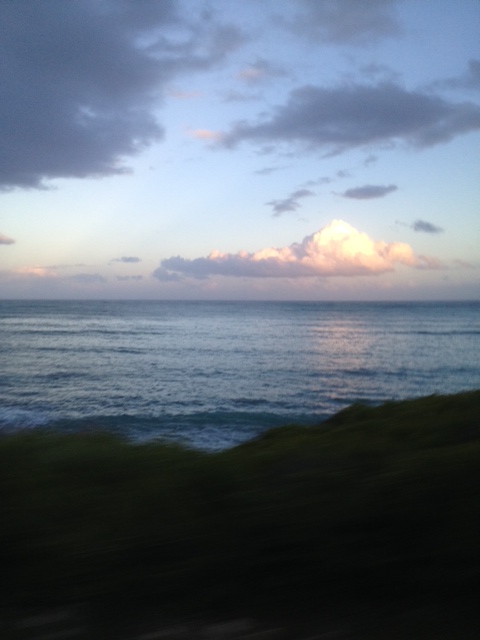
Z with All Our Cameras About to Take the Group Photo
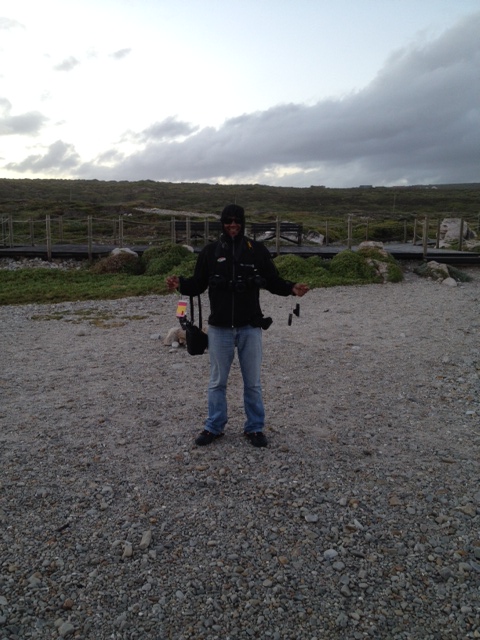
After getting up the next morning, we left Cape Agulhas and drove to the town of Hermanus. Hermanus is known to be one of the best places in Africa to see whales because they typically swim very close to the shore. Unfortunately, no whales were present during our short stop. Even if there were any present, I do not believe we would have been able to see them anyway because as predicted, the water was extremely choppy.
We then made our way to Betty’s Bay which is known for its colony of South African penguins. It was an amazing experience to see the penguins up close in their habitats, burrows dug into the South African brush.
Penguins Resting from their Fishing Expedition
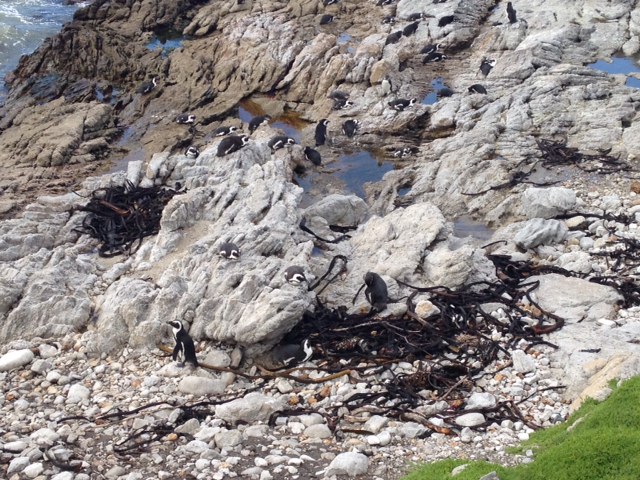
Penguin in a Burrow
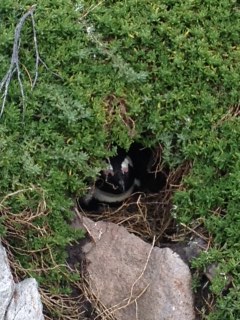
Penguin Chicks
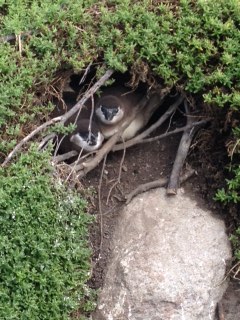
We finished our tour by driving back to Cape Town along Clarence Drive. On the way, our tour guide Z, took us through his home town, Strand. The town is well-named because Strand in Afrikaans means “beach” and the water literally lapped over the edge of the main road through the town. Z also pointed out the dock he used to go swimming from and the chemical factory where his mother and many Strand residents used to work. He also showed us a man-made island just off the coast of Strand that is being turned into a casino. The casino will not be ready for several years, Z said, but once it is, he hopes it will make Strand a major tourist destination and help support Strand’s residents. After our drive through Strand, we finally made our way back into Cape Town proper and back to our home away from home, our hostel 33 South. We had an amazing weekend and were sad to see it end, but look forward to our work week ahead!